Marc Weidenbaum's Blog, page 238
May 6, 2020
Buddha Machine Variations No. 23 (Voltage Redress)
The batteries were dying on one of the Buddha Machines, so I recharged them. But only a bit. Just enough to let them last for this recording. The green one on the left is the one giving out the dying-whale sounds, the dying Buddha. The blue one is fully charged. Both are sending loops of drones into the synthesizer.
There are only two channels into the mixer at the end of the line. One of them is straightforward, the second of the two. It is passing a tiny bit of sampled audio that changes every so often. That audio being sampled and looped is a snatch of one band of the blue Buddha Machine; that’s after it’s been extracted from the broader audio spectrum. The playing of the loop is being triggered by a square wave from the same module that is providing the overall clock for the rhythm heard. The moment at which the sample occurs, however, is triggered due to another square wave, which is moving at a slower pace. That’s channel two.
Channel one is built around the Muxlicer from the manufacturer Befaco. This is the first Buddha Machine Variation to include the Muxlicer. (All the other modules have been used in previous variations, so I’m not mentioning them in detail here.) The Muxlicer does many things. What it’s doing here is as follows. It has one main input, which received the direct line of the “dying Buddha,” the green one. There are eight “outs” from the Muxclicer. The dying Buddha is the default audio for each, its volume altering based on those eight faders. However, four of the tracks have alternate inputs, which override the dying Buddha. Of these alternate inputs, the first is a copy of the blue Buddha. The third, fifth, and sixth are all bands extracted from the blue Buddha. And on top of all that, the sequence of which of the eight outs is playing at any given time changes continuously, because they’re being randomly assigned by a sine wave that’s not sync’d to anything else. Sometimes the same out even plays twice in a row.
For further patch-documentation purposes, here’s a straight-on shot of the synthesizer:
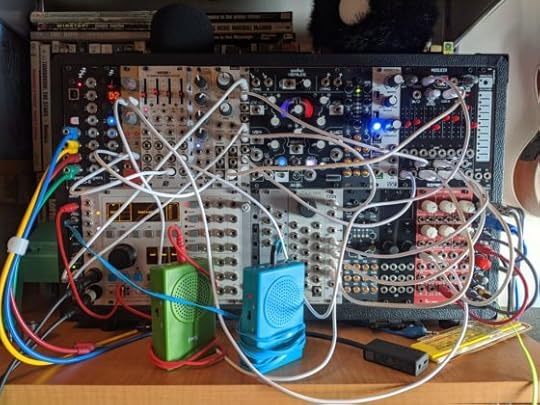
Video originally posted at youtube.com/disquiet. There’s also a video playlist of the Buddha Machine Variations.
May 5, 2020
Buddha Machine Variations No. 22 (Glitch Cycle)
One Buddha Machine, first generation, one loop. It’s split into three strands. One strand goes straight into the mixer. That’s channel one. One strand goes into the low-fidelity looper, which spits out little instant-recall snippets into the filter, which then sends three bands of audio spectrum to the mixer. Those bands are channels two, three, and four. And the third strand goes into the granular synthesizer, which yields channel five.
The first and second of those mixer channels, in turn, have their audio impacted by slow-ish waves (slowish to the extent that they’re not themselves audible): the second by a square wave; the first by a square wave that is, at heart, sync’d to the first, but is then delayed a smidgen. The brokenness of the overall beat comes from the combination of that delay and the underlying tiny loop.
All these modules have been used in recent patches in this variations series, with one exception: the looper, which is the UL1uloop from soundmachines.
For further patch-documentation purposes, here’s a straight-on shot of the synthesizer:
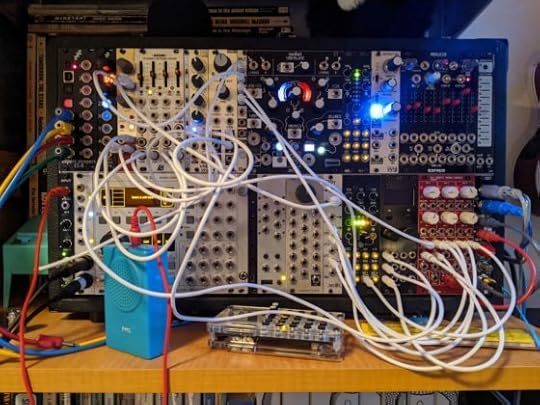
Video originally posted at youtube.com/disquiet. There’s also a video playlist of the Buddha Machine Variations.
May 4, 2020
Buddha Machine Variations No. 21 (Dark Pixels)
This variation on a loop from the first generation of the Buddha Machine was as much a test for the AV Squad as it was for the Music Department. I’m trying out a new camera, and the good news is the audio sounds good (as with yesterday’s, the audio was recorded straight to the camera, rather than with the device’s built-in microphone). Clearly I need to get a better viewing angle (at least it isn’t all fish eye like yesterday), and better light, but sound-wise it’s a step forward. And sound is the point.
As for the patch, the loop is heard in five simultaneous modes, left to right in the mixer. Leftmost is the raw audio, and next to that is audio out of the granular synthesizer. Both are having their relative volumes tweaked by sine waves pulsing in sequence. More on those in a moment. The third, fourth, and fifth of the mixer’s channels are all bands of the audio spectrum from the original signal.
The volume of the first and second channel are being raised and lowered in accordance with the relation between the three pulsing waves (the “and” and “or” paths in the Cold Mac module from Whimsical Raps). It’s more subtle than I’d hoped for, because there’s little if any overlap to build on, and I’ll work on that in the future. The third and fourth channels are the main place that pulsing comes from. A square wave at the start of the rotating sequence of pulses is triggering one, and then a gate delay (in the Ornament and Crime module, running Hemisphere) is pushing the other back a moment. In addition, the trigger on the granular synthesizer is receiving a trigger pulse from a square wave at the end of the four-pulse sequence. (I’m not listing the devices in detail because they’re the same ones I’ve mentioned here in recent projects.)
For further patch-documentation purposes, here’s a straight-on shot of the synthesizer:
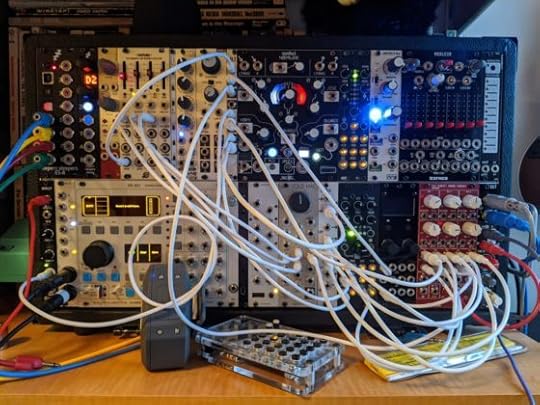
Video originally posted at youtube.com/disquiet. There’s also a video playlist of the Buddha Machine Variations.
May 3, 2020
Buddha Machine Variations No. 20 (Pattern Cognition)
This is a short one, and a change of approach. It’s a test run, really. (Every entry is an experiment of some sort.) Samples extracted from three different loops of the first-generation Buddha Machine, which dates from 2005, were recorded on the Teenage Engineering PO-33 K.O! and then run as a series of patterns, the patterns chained into a sequence. The samples are tuned. Audio goes out to a GoPro, via a Zoom H4n. That about covers it. The Buddha Machine shown here was the source of the samples, but it’s displayed for decoration only, since the sampling occurred prior to the video being shot.
Video originally posted at youtube.com/disquiet. There’s also a video playlist of the Buddha Machine Variations.
Current Listens: Cello + EMS Synthi 100 + Devs
Current Listens is a listening diary of sorts. It’s an answer to the frequent question: “What have you been listening to lately?” This is what’s on heavy rotation at home and … well, of late, pretty much just at home. It’s annotated, albeit lightly, because I don’t like re-posting material without providing some context.
And in the interest of conversation, if there’s something you’re enjoying lately, mention it in the comments below. Just please don’t use the comments to promote your own work. This isn’t the right venue. Likewise if you’re a publicist or work at a record label (if you are, just use email). Thanks.
▰ ▰ ▰ ▰ ▰ ▰ ▰ ▰ ▰ ▰ ▰ ▰ ▰ ▰ ▰
NEW: Recent(ish) arrivals and pre-releases
▰ Svetlana Maraš’ superb, rhythmically motivated Steps is exactly the sort of record I listen to so much that I never get around to writing about it. Except I am promising myself I will get around to doing so. It’s all performed on a single instrument, the EMS Synthi 100, which dates from the early 1970s. The one she’s playing is at Radio Belgrade’s Electronic Studio. As for those numerical track titles, Maraš explains: “Tracks are named by the number of sequencer steps used in that piece.”
▰ Robert Fripp, the King Crimson founder and guitarist, now has his own YouTube channel: “We will be releasing an ambient instrumental soundscape online every week for 50 weeks. Something to nourish us, and help us through these Uncertain Times.” The first track is up. I tweeted about this on Friday and yet, per my comment directly above, entirely neglected to mention it here until now.
▰ The Devs score is finally out, as of late last week. This is the music composed for Alec Garland’s excellent science fiction TV series, which recently ran on Hulu for eight episodes. The music from Geoff Barrow, Ben Salisbury, and the Insects (the duo of Tim Norfolk and Bob Locke) is generally haunting, but brace yourself for when tracks like “Stealing the Code” and “Suffocation” bring the tension to the fore. Lacking from the release are the show’s prominently employed pre-existing cues, like tracks from the Hilliard Ensemble and Steve Reich.
Devs (Original Series Soundtrack) by Ben Salisbury, The Insects, Geoff Barrow
▰ Club aesthetics glitched and filtered, vocals on stutter, tone on stun: Loraine James has this subdued-ish track (120 BPM) on the Awesome Aid compilation (“100% of earnings will go to the artists”), out a couple weeks ago. (And thanks, rbxbx, for the alert.)
▰ A gorgeous live performance by Marcus Fischer and Ted Laderas (both of who worked on the music for the film Youth, which I did music supervision for). This is their brand new release, February 29th, which came out two days ago. It’s a single track, just under 25 minutes, recorded on the date that gives the piece its title. All profits from sales go to a women’s shelter in Portland, Oregon. The wonderful ingredients are cello, vibraphone, electronic processing, and the sonic spaciousness of the venue at which it was performed.
February 29th by Marcus Fischer + Ted Laderas
▰ Polygoss’ Coronal is all quiet noises, ruffled textures, and primordial synthesis. The mix of birdsong and fractured wave forms on “Melismas” is a favorite. It came out on May 1.
▰ ▰ ▰ ▰ ▰ ▰ ▰ ▰ ▰ ▰ ▰ ▰ ▰ ▰ ▰
REPEAT: Favorites mentioned previously
▰ Muffled voices push at the surface music of “Forever Listening,” the surveillance-themed lead track of Jasmine Guffond’s recent album, Microphone Permission. It was released in early March on Editions Mego.
Microphone Permission by Jasmine Guffond
▰ This rapturous quartet (piano, flute, bass clarinet, violin), “Intangible Landscapes” by composer Yaz Lancaster, moves from stately restraint to operatic dramatics over the course of its meticulously plotted 12-plus minutes.
▰ ▰ ▰ ▰ ▰ ▰ ▰ ▰ ▰ ▰ ▰ ▰ ▰ ▰ ▰
ARCHIVAL: Old(er(ish)) records top mind
▰ Even with all the death of late, the world skipped a beat this week when the great drummer Tony Allen passed away at the age of 79. This is a favorite, dubby track from 1984. The title stands for “Never Expect Power Always.” Ain’t that the truth.
▰ Word got out a few days ago that Jon Hassell, the innovator behind the retro-future music known as Fourth World, is in failing health. His first album, dating from 1977, the great Vernal Equinox, was just reissued in March.
May 2, 2020
Current Listens: Needle Drop
Tomorrow begins a new section on this website. It’s to be called Current Listens, and that’s what it’s about. To a degree, it’s an answer to a frequent question I receive: “What have you been listening to lately?” It may prove to be an experiment, and it may prove to last long-term. It’s going to be a weekly collection of recommended listening. The list may be long some weeks, and short other weeks. The descriptions will be concise, or as concise as I can be. I don’t, personally, enjoy posting without context. That’s just me. Below is some background on the idea:
I try to write about a track each weekday on Disquiet.com. That’s what the site’s Downstream section is about (though lately it’s been, entirely uncharacteristically, full of modified recordings, in the form of my own Buddha Machine Variations). There’s far more music, however, that I’m interested in than I can write about in that focused context. I receive hundreds of email requests most weekdays (from musicians, record labels, publicists) to listen, and I “discover” lots in my own listening and exploring.
This next point is worth its own paragraph for emphasis: Most of what I write about is music I come upon, not music that is sent to me. That isn’t because I necessarily trust my explorations more than my inbox. It’s just that exploring the internet is more interesting than exploring my inbox. (Also more interesting than email: visiting record stores, going to concerts, having conversations.)
It’s been suggested to me on several occasions that I address this perceived burden (an embarrassment of riches, to be clear) by just re-posting to Disquiet.com lots of the inbound music, and to let readers sort it out. I feel, though, that would merely shift the burden. The point of publishing Disquiet.com, which I started back in 1996, is for it to be mine, to have an editorial point of view, to present things from my perspective. (Even as I’ve experimented with having guest contributors, that remains the case.) More importantly, the “embarrassment of riches” (of being surrounded by vast amounts of music) mentioned above is no longer solely the experience of the music critic. Thanks to streaming services, everyone has too much to listen to; even if their email inboxes don’t overflow with requests, their more broadly defined inboxes do.
It’s also been suggested to me I get back to putting together playlists on streaming services. I’ve given this a go on SoundCloud, Spotify, and Google Play Music in the past. I enjoyed it to a degree, but the absence of context, of producing liner notes, made it less interesting than it could be (again, for me). I did two episodes of a podcast, which was a lot of fun, but also a sizable amount of work. I may get back to it, but blogging is where all this Disquiet activity began. It’s worked, and it still works.
Which is where this new Current Listens section comes in. Current Listens is a listening diary, of a sorts. It’ll collect recent-favorite music I haven’t (or at least haven’t yet) done a longer weekday entry on. Much of this music is available on a variety of formats and platforms, not just whichever one I happen to utilize for embedding purposes. Current Listens will kick off with three categories:
New: Recent(ish) arrivals and pre-releases
Repeat: Favorites mentioned previously
Archival: Old(er(ish)) records on my mind
Check it out tomorrow. Thanks. And in the interest of conversation, if there’s something you’re enjoying lately, mention it in the comments below. Just please don’t use the comments to promote your own work. This isn’t the right venue.
Buddha Machine Variations No. 19 (Broken Steps)
This patch follows up the one from two days ago, “Step Wise,” No. 17 in this series. There, as here, alterations in square waves were used to instantiate some melodic activity amid what otherwise would be a more static operation. The difference is that in “Step Wise,” a single square wave went back and forth, slowly alternating at an even pace between relative high and low. Here the square wave is a little more complicated, a little more rough, a little more varied. And what it produces happens in murkier territory.
There are four channels of audio going into the mixer at the end of the chain, all at pretty much the same volume level. The source audio at the start of the chain is one loop from one Buddha Machine, first generation, going through granular synthesis. The granular synthesis then goes into a filter bank that splits the audio into bands spread across the spectrum.
The first and second channels are simply mid- and low-range bands from the filter bank. The third channel is where the echoing effect comes from: a series of staged delays activating on a low-level band of the filter bank. The fourth channel is more for background haze: a high-level band from the filter bank goes through a granular delay and then through some heavy reverb.
I’m not going to list all the modules used, since they’ve been used in recent pieces in this series to the same purposes. The main thing to keep an eye on is the left side of the tiny screen on the bottom level, the black module three in from the right (it’s an Ornament and Crime running an alternate firmware called Hemispheres, specifically the Scope utility). That’s a scope image of the voltage that’s motivating the changes in overall pitch. That little blue object hovering in space is taking the output signal of the combined Batumi/Dixie/S.P.O. modules and sending it both into the octave control of the granular synthesizer, and into the Ornament/Hemispheres oscilloscope. If you watch it, you’ll see horizontal lines go up and down, and occasionally splinter. The wave causing that visual activity is a somewhat complex one that combines two square waves in the SPO: a slow-moving one from the Batumi, and a slightly faster-moving one from the Dixie. The pitch of the latter in turn is itself being occasionally altered in pitch by a sine wave, also from the Batumi. That’s all parsed in the S.P.O., and yields the relative volumes shifts in the initial granular synthesis of the source loop.
For further patch-documentation purposes, here’s a straight-on shot of the synthesizer:
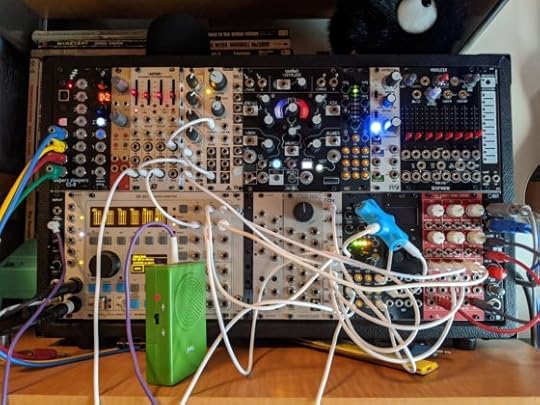
Video originally posted at youtube.com/disquiet. There’s also a video playlist of the Buddha Machine Variations.
This Week in Sound: An Opportunity to Listen
These sound-studies highlights of the week are lightly adapted from the April 27, 2020, issue of the free Disquiet.com weekly email newsletter This Week in Sound (tinyletter.com/disquiet).
As always, if you find sonic news of interest, please share it with me, and (except with the most widespread of news items) I’ll credit you should I mention it here.
▰ ▰ ▰ ▰ ▰ ▰ ▰ ▰ ▰ ▰ ▰ ▰ ▰ ▰ ▰
THIS WEEK IN SOUND
▰ “[T]here is some research showing that younger children distrust voice assistants,” writes Eric Hal Schwartz. “That may be partly because they have trouble being understood.” Schwartz is covering a recent investment in the company SoapBox, which is developing children-focused speech recognition technology.
https://voicebot.ai/2020/04/20/soapbox-labs-raises-6-3m-investment-for-kid-focused-speech-recognition-tech/
▰ “We have an opportunity to listen – and that opportunity to listen will not appear again in our lifetime.” That’s Cornell-based marine acoustician Michelle Fournet speaking with writer Karen McVeigh about how the Covid-induced silence has provided whales, among other sea creatures, a respite from noise, and those who study aquatic life a unique vantage.
https://www.theguardian.com/environment/2020/apr/27/silence-is-golden-for-whales-as-lockdown-reduces-ocean-noise-coronavirus
▰ “Jail and prison officials in at least three states are using software to scan inmate calls for mentions of the coronavirus. … Known as Verus, it was first deployed several years ago to forestall suicide attempts, mine calls for investigative tips, and for a range of other purposes.” (via Subtopes, Alice Speri)
https://theintercept.com/2020/04/21/prisons-inmates-coronavirus-monitoring-surveillance-verus/
▰ “The bear was probably the hardest animal to make sound believable,” Hinterland Studio audio director Glenn Jamison tells writer Lauren Morton as part of her overview of how animal noises are recorded for video games. Other tidbits: “Animals as a rule of thumb are often fairly quiet and generally only vocalise if something is happening, for example when they feel threatened or during mating rituals.” “Another animal which surprised me was the polar bear which purrs when content.” (via Simon Carless’ excellent Video Game Deep Cuts email newsletter)
https://www.pcgamer.com/how-animal-sounds-are-made-in-games/.
▰ ▰ ▰ ▰ ▰ ▰ ▰ ▰ ▰ ▰ ▰ ▰ ▰ ▰ ▰
GRACE NOTES
▰ Field recordings are sonic readymades.
▰ Such a tremendous opportunity. For week 11 of my Sounds of Brands course, we had the incredible Marcos Alonso (thank you!), creator of the great Samplr iOS music app, in class (well, via Zoom) to discuss interface design, the visualization of sound, and how bugs become features. I may post some material from the presentation and discussion in the future.
▰ Five Weeks Ago: Well, at least there are no late fees at the libraries. This Morning: That pile of books is sorta tall and in the way.
▰ A bit more, in video form, on the MIDI device Tom Whitwell made based on a request I’d made for a highly portable controller:
https://youtu.be/MMdNFOrmqeQ?t=9787.
▰ Related: Been locked down so long I’m almost used to not wearing a backpack. Well, kinda almost.
▰ Huh, Reverb LP shut down about two months ago. I had no idea.
▰ Occasional reminder that since folks are streaming, instead of performing in person, the San Francisco Bay Area’s excellent experimental-music calendar is of use to anyone with an internet connection and an interest in the music:
https://bayimproviser.com/calendar.aspx.
▰ “Waiting for the organizer to arrive.” I remember when I’d post (tweet, generally) these bits of conference-call hold-status detail, and people would find them humorous, even alien. Now such circumstances are part of a lot more people’s lives, and make up a lot more of those daily lives.
▰ I was already forgetting the Tuesday noon siren before Tuesdays became less a concrete temporal reality and more of a kind of fungible concept. (Context: The weekly public-warning tests here in San Francisco went on a two-year hiatus late last year.)
▰ Folks ask about a paid version of the This Week in Sound email newsletter. I don’t think, at the moment, I’d do that. Substack’s minimum fee is $5/month, I think, which is more than I’d expect someone to pay. I may add a “tip jar” at some point. The main tips I’d appreciate, though, are examples of sound you come across.
▰ ▰ ▰ ▰ ▰ ▰ ▰ ▰ ▰ ▰ ▰ ▰ ▰ ▰ ▰
Subscribe to This Week in Sound at (tinyletter.com/disquiet).
May 1, 2020
Buddha Machine Variations No. 18 (Qin Error)
Like pretty much all of these Buddha Machine Variations thus far, this one began with a concept, an approach. And like most of them, it ended up someplace else — less else than others, but else nonetheless. The initial technical concept was unusually precise, in that I plugged in a good half of these cables before even turning on the synthesizer, or plugging in the source audio. The audio is from the third-generation Buddha Machine, also known as Chan Fang, which dates from 2010. The loop heard here, like the others on the device, was originally performed with the qin, an ancient Chinese zither. (I once saw an epic Chinese film involving a master qin player and every time the qin was mentioned, the subtitles would say “zither,” like the audience hadn’t yet committed this fact to memory. Over time, of which there was quite a bit, this being an epic, the constant appearance of this translation got the audience laughing, which was rarely the tone the movie was going for.)
My initial goal here was to employ a technique from the previous three variations, but to try a different take on it. This involves a module that takes two inputs and sends out one output, either the lowest (the AND route) or the highest (the OR route) of the two inputs at any given time. In the previous variations, I applied this to inbound audio. This time, I sent CV (control voltage, if you’re new to synthesizers) through it, hybrid waves that were themselves the product of two combined waves. Those two outputs, the AND and OR, were then applied to the relative volume of two of the five channels in the mixer.
Here’s the mixer breakdown, starting from the leftmost channel. Channel one is … well, this is a bit odd. It’s an error. It was to be a bit of granular synthesis applied to input from the source audio. But at some point I accidentally unplugged something, and when I went to plug it back in, I simply had one input from the module going to the main input. Somehow this module continued to produce sound from earlier, so that is heard throughout, quietly. Its volume is being varied based on the AND of that comparison mentioned in the previous paragraph.
Channel two is a narrow band of the audio spectrum of the Buddha Machine loop, its volume being varied based on the OR of that comparison mentioned above. Channel three is the series of three echoes heard throughout, all delays of one band of the source audio. Channel four is a mid-level narrow band of the loop’s audio spectrum, with no volume alteration. Channel five is the lowest-level heard of the audio spectrum sent through a heavy amount of reverb, so much so that it provides a near continuous hum.
And that about covers it. I’m not going to list all the modules used, since they’ve been used in recent pieces in this series to the same purposes. I will add one module-specific note: All three of the repetitions in mixer channel three come from the same single channel of the ER-301. Previously I was doing one delay in one channel and one delay in another, but it was unnecessary. Also, this is the second time I’ve done the video from an angle, which is OK, but I realize that I failed, as a result, last time to fully document the organization of the array of cables, so here’s a still shot from straight on:
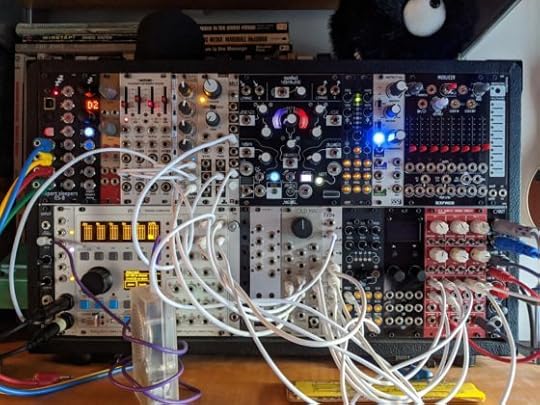
Video originally posted at youtube.com/disquiet. There’s also a video playlist of the Buddha Machine Variations.
April 30, 2020
Disquiet Junto Project 0435: Woodshed Report
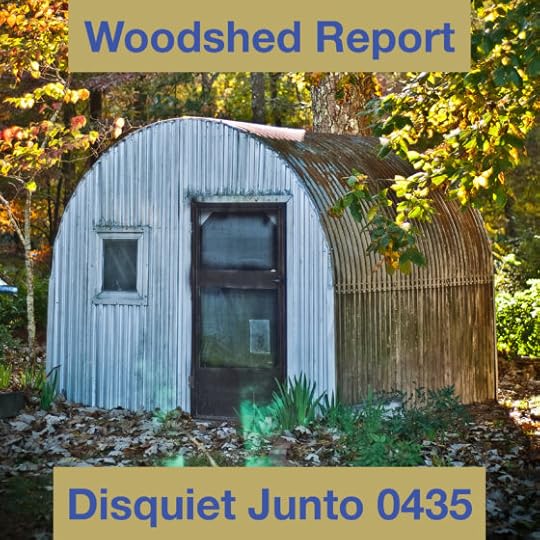
Each Thursday in the Disquiet Junto group, a new compositional challenge is set before the group’s members, who then have just over four days to upload a track in response to the assignment. Membership in the Junto is open: just join and participate. (A SoundCloud account is helpful but not required.) There’s no pressure to do every project. It’s weekly so that you know it’s there, every Thursday through Monday, when you have the time.
Deadline: This project’s deadline is Monday, May 4, 2020, at 11:59pm (that is, just before midnight) wherever you are. It was posted on Thursday, April 30, 2020.
These are the instructions that went out to the group’s email list (at tinyletter.com/disquiet-junto):
Disquiet Junto Project 0435: Woodshed Report
The Assignment: Share something you’ve been working on (and respond to what others post).
Step 1: The past six weeks of Disquiet Junto projects have encouraged and rewarded collaboration. This week’s is more insular. There’s no formal constraint. Just share a recent piece of music, or create a new piece for this week.
Step 2: After uploading your track, please take a few minutes to listen to and respond to tracks by other participants.
If you’re interest in background on the concept of the “woodshed,” here’s video of a talk I gave a little over a year ago on how it relates to the Disquiet Junto:
https://www.youtube.com/watch?v=GzHrOpBwhMU
Seven More Important Steps When Your Sample Kit Is Done:
Step 1: Include “disquiet0435” (no spaces or quotation marks) in the name of your tracks.
Step 2: If your audio-hosting platform allows for tags, be sure to also include the project tag “disquiet0435” (no spaces or quotation marks). If you’re posting on SoundCloud in particular, this is essential to subsequent location of tracks for the creation of a project playlist.
Step 3: Upload your tracks. It is helpful but not essential that you use SoundCloud to host your tracks.
Step 4: Post your tracks in the following discussion thread at llllllll.co:
https://llllllll.co/t/disquiet-junto-project-0435-woodshed-report/
Step 5: Annotate your tracks with a brief explanation of your approach and process.
Step 6: If posting on social media, please consider using the hashtag #disquietjunto so fellow participants are more likely to locate your communication.
Step 7: Then listen to and comment on tracks uploaded by your fellow Disquiet Junto participants.
Additional Details:
Deadline: This project’s deadline is Monday, May 4, 2020, at 11:59pm (that is, just before midnight) wherever you are. It was posted on Thursday, April 30, 2020.
Length: The length is up to you.
Title/Tag: When posting your tracks, please include “disquiet0435” in the title of the tracks, and where applicable (on SoundCloud, for example) as a tag.
Upload: When participating in this project, be sure to include a description of your process in planning, composing, and recording it. This description is an essential element of the communicative process inherent in the Disquiet Junto. Photos, video, and lists of equipment are always appreciated.
Download: Given the nature of this particular project sequence, it is best to set your track as downloadable and allowing for attributed remixing (i.e., a Creative Commons license permitting non-commercial sharing with attribution, allowing for derivatives).
For context, when posting the track online, please be sure to include this following information:
More on this 435th weekly Disquiet Junto project, Disquiet Junto Project 0435: Woodshed Report — The Assignment: Share something you’ve been working on (and respond to what others post) — at:
More on the Disquiet Junto at:
Subscribe to project announcements here:
http://tinyletter.com/disquiet-junto/
Project discussion takes place on llllllll.co:
https://llllllll.co/t/disquiet-junto-project-0435-woodshed-report/
There’s also a Disquiet Junto Slack. Send your email address to twitter.com/disquiet for Slack inclusion.
Image associated with this track is by Josh Self, used thanks to a Creative Commons license and Flickr. The image has been cropped, colors shifted, and text added.



